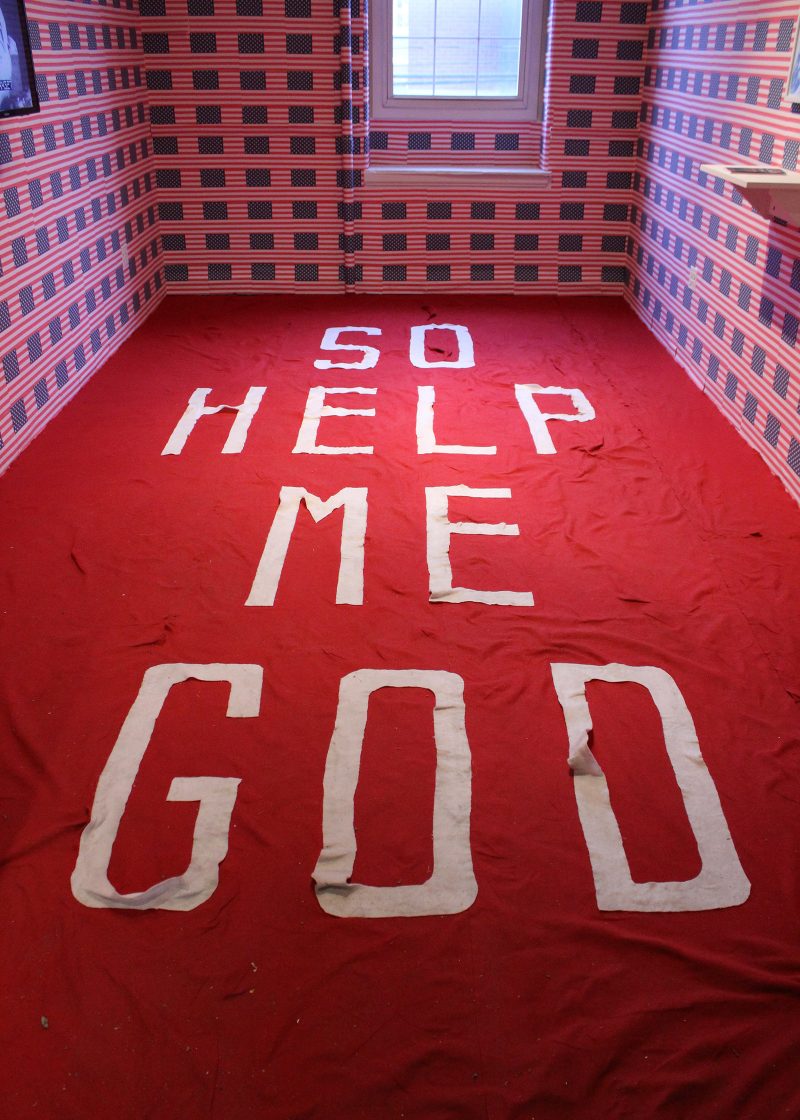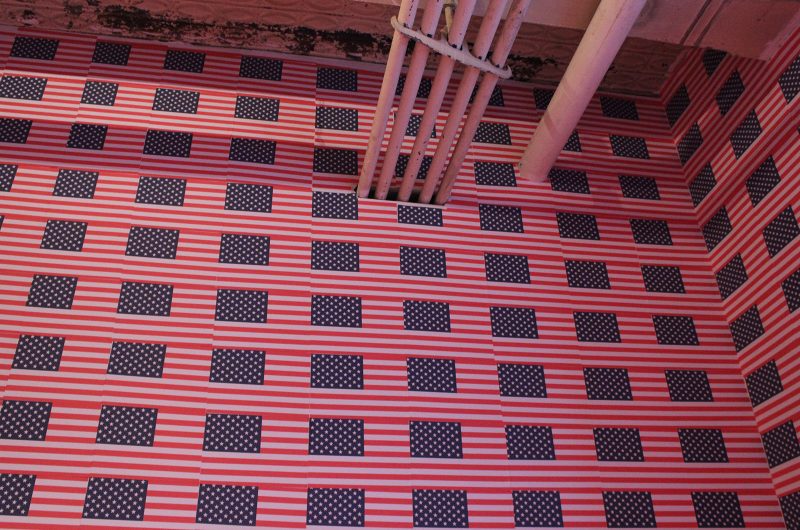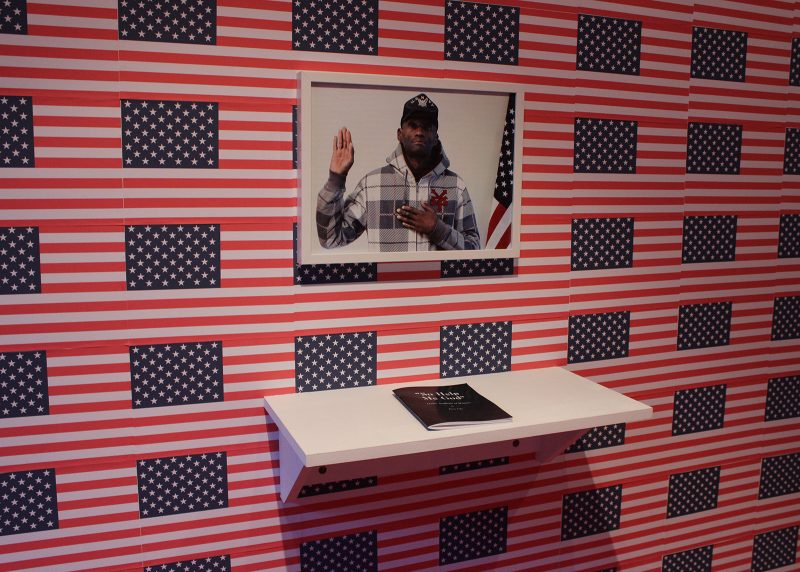
If there is one thing that art-seekers wouldn’t expect to find at 319 N. 11th Street–amidst the likes of Vox Populi, Tiger Strikes Asteroid, Grizzly Grizzly, and a number of others–it would be a grandiose display of American exceptionalism. December at Napoleon, however, presents visitors with just such a vision of unbridled, cloying patriotism for the exhibit “So Help Me God” by France- and Spain-based artist Pierre Valls.
Jarring jingoism
The approach to Napoleon’s doorway is jarring, as visitors are met by the repeat-pattern, floor-to-ceiling American flag wallpaper inside that makes the average patriotic displays at a 4th of July picnic appear like an affront to the U.S. Constitution by comparison. Numerous visitors at the First Friday opening were visibly uneasy at this unanticipated, flag-waving jingoism in their midst, but beneath the edifice lies a powerful critique.
Covering the entire floor, a red and white felt-cutout carpet reading ‘So help me God’ harnesses the language of oaths in the United States to place the exhibit in a specific legal and psychological context. Used by jurors and witnesses, public officials and military enlistees, the phrase has a longstanding tradition as a means to assert and justify the oath taker’s duty. The phrase also introduces a level of God-fearing into the process, regardless of the particular (if any) religious inclination of the oath taker.
A video monitor on one of the walls plays a short, looping video compiled from a variety of found sources. Beginning with a brief interview of a homeless veteran, known anonymously as ‘Stevens’ to protect his identity, the footage marches on to show us medical images of a model human brain and newsreels from the Chevrolet Motor Company. The film concludes with a ceremony for a group of young army cadets taking their oath of enrollment, and appropriately ends with them promising to uphold the duties ‘So help me God.’
Broken vows
Despite all the triumphant externalities of the gallery’s stars and stripes, the nationalism finds itself supplanted by a short clip which resides near the middle of the video. The short segment is somewhat obscured by the rest of the regalia in the show, and without watching the entire video, it might be overlooked. Its contents, though, home in on the heart of the exhibit. In a video obtained by Wikileaks, we see from the perspective of a U.S. military Apache helicopter which hovers while it awaits clearance to fire on a vehicle as it is loaded with dead bodies. The footage was annotated after the fact to indicate with arrows where two live children sat inside the vehicle.
Eventually the helicopter opens fire on the van, resulting in chaos and a cloud of dust on the ground. With the van disabled, the full clip shows ground troops moving in to secure the scene. The attack ultimately injured both children and killed a number of others, including two Reuters news employees–Saeed Chmagh and Namir Noor-Eldeen.

Pierre Valls brings “So Help Me God” to Napoleon courtesy of curator Nichola Kinch, and the installation belongs to a larger project entitled “Oaths: Aesthetic of Memory.” Begun in Cuba in 2016, the examination of military indoctrination, national loyalty, and the cognitive dissonances that frequently accompany them will travel across America, Europe, and the Middle East in the coming two years. Valls plans to take on analogous systems around the globe, so as to better understand fighters and veterans, as well as their attitudes and behaviors.
Cognitive dissonance
Looking back on Stevens, who we met briefly in the video, we must reconcile the propaganda with the often bleak realities of military life. With growing awareness of the PTSD, substance abuse, and other mental and physical hurdles men and women bring home with them from war zones, it is no secret that the honor and the glory many go seeking must also be tempered with the painful reality of combat experience. Stevens, although not an addict, does live on the streets, estranged from his family. He has trouble with close human contact, struggles with being in confined spaces. Besides witnessing a friend’s death firsthand, he was injured in combat and returned to Philadelphia, but his troubles kept him from fully assimilating to his home.

Valls met with veterans like Stevens, and using the recitation of the oath of enlistment, attempted to unlock and explore their memories. The artist does not claim any hard-and-fast scientific basis for his examinations, only a desire to connect with people. An accompanying printed text rests beneath a photo of Stevens directly across from the video screen, and it details the oaths, his meeting with Stevens, and other interpretations about combat psychology. The oath, Valls posits, is the ultimate step toward an individual’s ability to kill; a cognitive step at the end of a training process that allows for the suspension of other faculties. How else might one justify firing a 30mm cannon into a van with two children inside?
The human brain is among the most unique and adaptable of nature’s wonders, but it is not without its faults. When we encounter information again and again, regardless of its relation to the truth, it becomes easier to accept. Comforting falsehoods are often more palatable to us than painful truths, and the sway that groupthink and indoctrination hold over our choices is very often greater than even our built-in moral compass.
In “So Help Me God,” Valls does not explicitly condemn or elevate any agenda, although his critique of the war machine speaks somewhat more loudly than the freedom that supposedly rings from the flags. This is only evident, however, after reflecting on the video and written material. By attempting to understand those who choose the military as a way of life, and how they are subsequently affected, this project unearths a slew of complex emotions. The title itself begins to seem more like a plea for help than an oath in this light. Empathy is rightfully the most compelling thread of this exhibit, because even in the midst of enthralling symbolism and violent horror, the human element underscores all.








